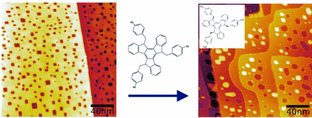Modification and functionalization of the atomic-scale structure of insulating surfaces is fundamental to catalysis, self-assembly, and single-molecule technologies. Specially designed syn-5,10,15-tris(4-cyanophenylmethyl)truxene molecules can reshape features on an ionic KBr (001) surface. Atomic force microscopy images demonstrate that both KBr monolayer islands and pits can reshape from rectangular to round structures, a process which is directly facilitated by molecular adsorption. Simulations reveal that the mechanism of the surface reconstruction consists of collective atomic hops of ions on the step edges of the islands and pits, which correlate with molecular motion. The energy barriers for individual processes are reduced by the presence of the adsorbed molecules, which cause surface structural changes. These results show how appropriately designed organic molecules can modify surface morphology on insulating surfaces. Such strongly adsorbed molecules can also serve as anchoring sites for building new nanostructures on inert insulating surfaces.
